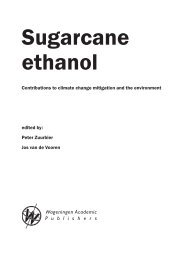Production and use of fuel ethanol in Brazil - BAFF
Production and use of fuel ethanol in Brazil - BAFF
Production and use of fuel ethanol in Brazil - BAFF
Create successful ePaper yourself
Turn your PDF publications into a flip-book with our unique Google optimized e-Paper software.
34<br />
A4. Institutional <strong>and</strong> economic aspects <strong>of</strong><br />
sugar-cane grow<strong>in</strong>g<br />
A4.1.<br />
What is the sugar-cane crop period <strong>in</strong> <strong>Brazil</strong>’s<br />
Center-South region?<br />
The <strong>Brazil</strong>ian sugar <strong>and</strong> <strong>ethanol</strong> <strong>in</strong>dustry is a processor <strong>of</strong> the agricultural product that<br />
is sugar-cane. Sugar-cane is a type <strong>of</strong> grass that, once matured, has a great content<br />
<strong>of</strong> sugars (approximately 1/3 <strong>of</strong> the dry stalk matter). Sugar-cane is a semi-perennial<br />
crop, as it can be harvested with no need for replant<strong>in</strong>g fro 5 to 7 harvest<strong>in</strong>g seasons<br />
(i.e. 5 to 7 years). Follow<strong>in</strong>g that period, a rotation can be made by grow<strong>in</strong>g a<br />
different crop <strong>in</strong> the l<strong>and</strong> for one crop period (peanuts, for example), whereupon<br />
sugar-cane grow<strong>in</strong>g is resumed.<br />
In <strong>Brazil</strong>’s Center-South region, the sugar-cane harvest<strong>in</strong>g period extends for<br />
8 months, on average, commenc<strong>in</strong>g <strong>in</strong> April <strong>and</strong> end<strong>in</strong>g <strong>in</strong> November. Once it is<br />
harvested, sugar-cane cannot be stored; it must be received at the <strong>in</strong>dustrial plant<br />
with<strong>in</strong> no longer than 72 hours <strong>of</strong> its harvest<strong>in</strong>g <strong>in</strong> order to avoid quality losses due<br />
to the action <strong>of</strong> bacteria <strong>and</strong> yeasts. Sugar-cane harvested more than 5 days earlier is<br />
usually not accepted by the plants. For this reason, <strong>ethanol</strong> is produced from sugarcane<br />
dur<strong>in</strong>g only 8 months <strong>of</strong> the year, when sugar-cane is available. For the other 4<br />
months, the plant stops <strong>and</strong> undergoes ma<strong>in</strong>tenance procedures.<br />
S<strong>in</strong>ce the dem<strong>and</strong> for sugar <strong>and</strong> <strong>ethanol</strong> is constant dur<strong>in</strong>g the 12 months <strong>of</strong> the year,<br />
the amount <strong>of</strong> <strong>ethanol</strong> produced dur<strong>in</strong>g the 8 crop months must be sufficient to<br />
supply the market with the <strong>fuel</strong> all through the year (lead<strong>in</strong>g to storage costs).<br />
The <strong>in</strong>dustry also has to adjust to other typical characteristics <strong>of</strong> agriculture: crop<br />
falls or <strong>in</strong>creases due to climatic conditions or other variable that can lead to conflicts<br />
between supply <strong>and</strong> dem<strong>and</strong>.<br />
A. Fuel <strong>ethanol</strong>: Activities <strong>in</strong> <strong>Brazil</strong> <strong>and</strong> the world context












